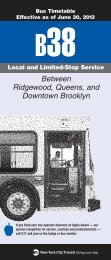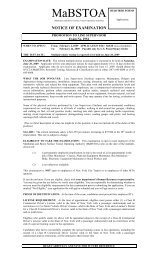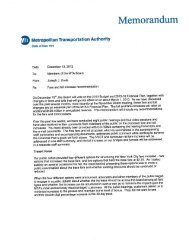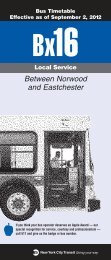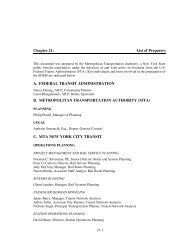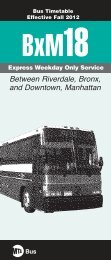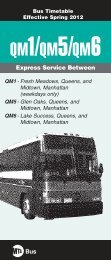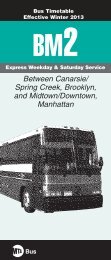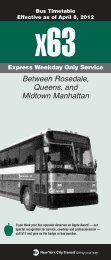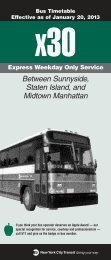Greening Mass Transit & Metro Regions: The Final Report - MTA
Greening Mass Transit & Metro Regions: The Final Report - MTA
Greening Mass Transit & Metro Regions: The Final Report - MTA
You also want an ePaper? Increase the reach of your titles
YUMPU automatically turns print PDFs into web optimized ePapers that Google loves.
82<br />
kW (kilowatts) of self-generation from solar photovoltaic (PV) panels. <strong>MTA</strong> is estimating the costs to meet 1% of its power<br />
demand via renewable power in 2009, gradually stepping up its purchases and self-generation to meet its 7% goal by<br />
2015. In addition to helping New York State meet its renewable goals, renewables can provide <strong>MTA</strong> with long-term price<br />
certainty in an era of increasing fossil fuel prices. Demand for natural gas will continue to increase, driving up prices, particularly<br />
with the advent of U.S. greenhouse gas regulations that impose a cost on carbon dioxide emissions. Using natural<br />
gas to generate electricity produces much less carbon dioxide than coal-fueled generation with which it competes.<br />
In order to progress towards the goal of increased renewable energy use, <strong>MTA</strong> tasked Booz Allen Hamilton to review<br />
opportunities to develop wind energy on <strong>MTA</strong> properties and rights of way. Prime wind locations are flat, open areas with<br />
consistent wind speeds. <strong>The</strong> majority of wind development in the northeastern US has been in upstate New York, where<br />
Class 4 and higher winds exist.<br />
Additional information on this subject is available at www.mta.info/environment.<br />
Smart Growth/TOD – Bicycles As A <strong>Transit</strong> Link<br />
<strong>MTA</strong> Blue Ribbon Commission on Sustainability and the <strong>MTA</strong> Smart Growth-TOD Working Group<br />
Developed by Ned Sullivan, George Beane and the Smart Growth/TOD Working Group<br />
Introduction<br />
An objective of the <strong>MTA</strong> is to “develop and implement programs to improve the environment.” 1 <strong>The</strong> <strong>MTA</strong> plays a key<br />
role in Mayor Bloomberg’s PlaNYC for a Greener, Greater New York2 and should, either by interaction or example, play<br />
a leadership role in other city and federal transportation improvement programs3 as well.<br />
PlaNYC’s Transportation Initiative 9 calls for the city to promote cycling in various ways including “the implementation<br />
of the city’s 1,800-mile bike lane master plan” and “increasing necessary bicycling infrastructure” such as bike racks<br />
and lockers. Doubling the number of intra-city bike commuters is a key goal of the NYC Department of Transportation’s<br />
strategic plan. 4 A bill to promote reasonable bicycle access by employees at existing office buildings5 has been introduced<br />
in the City Council’s Transportation Committee and is being redrafted with input from the Mayor's office, DOT, and other<br />
interested parties. <strong>The</strong> Department of City Planning intends to propose a Bicycle Parking Zoning Text Amendment requiring<br />
appropriate indoor bicycle parking facilities in all new buildings.<br />
<strong>The</strong>re has been an enormous increase in non-recreational cycling in New York and, if the experiences of other cities around<br />
the world can be a guide, the number of intra-city cyclists will increase dramatically as cycling becomes safer and more<br />
convenient. To reduce traffic congestion and air pollution, the <strong>MTA</strong> should play a prominent role in promoting cycling for<br />
inter- and intra-city commuters and for recreational cyclists who wish to enter and leave the city. <strong>The</strong> inclusion of bicycling<br />
in the transportation mainstream has become a national objective and this Working Group recommends that it become a<br />
priority of the <strong>MTA</strong>.<br />
Bicycle Recommendations<br />
<strong>The</strong> Smart Growth/TOD Working Group makes the following recommendations to encourage and facilitate the use of<br />
bicycles as part of <strong>MTA</strong> passengers’ travel from point of origin to point of final destination.<br />
1. Promote and facilitate bike parking at stations<br />
2. Promote and facilitate bike transport on trains and buses<br />
3. Promote and facilitate bike storage at <strong>MTA</strong> work sites<br />
4. Provide consolidated and easily accessible information<br />
5. Act as an advocate and partner in promoting the use of bicycles as a sustainable link in urban and regional transit<br />
1 http://www.mta.info/nyct/facts/ffenvironment.htm<br />
2PlaNYC: A Greener, Greater New York; Transportation chapter, pp 72-97, pp 150-151.<br />
3For example, <strong>The</strong> Transportation Equity Act for the 21st Century (TEA-21); U.S. Code, Title 23, Section 217; U.S. Code, Title 49, Section II, Ch. 49-III §5501(3): “<strong>The</strong> National<br />
Intermodal Transportation System shall include significant improvements in public transportation necessary to achieve national goals for improved air quality, energy conservation,<br />
international competitiveness, and mobility for . . . economically disadvantaged individuals in urban. . . areas of the United States”; TEA-21 §3037(f): “. . . In awarding grants<br />
under this section . . . the Secretary shall consider . . . in the case of an applicant seeking assistance to finance an access to jobs project, the need for additional services in the<br />
area to be served by the applicant (including bicycling) to transport welfare recipients and eligible low-income individuals to and from specified jobs, training, and other employment<br />
support services . . .”<br />
4http://home2.nyc.gov/html/dot/html/pr2008/pr08_024.shtml 5NYC Council Intro. 871-2008, <strong>The</strong> Bicycle Access Bill.



